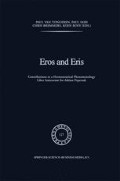Summary
Cusanus’s work De visione dei, at once a theoretical treatise on mysticism and a practical manuductio into it, stresses the cognitive element in an otherwise negative theology. It reveals the influences of Pseudo-Dionysius, Albert of Cologne, Eckhart, and possibly Ruusbroec (or at least that of his follower, Denys the Carthusian). It centres around the theme of seeing God which it identifies with being seen by Him. It features a Neoplatonic theory of form interpreted, however, through a very original Christology.
Access this chapter
Tax calculation will be finalised at checkout
Purchases are for personal use only
Preview
Unable to display preview. Download preview PDF.
Notes
Jasper Hopkins, Nicholas of Cusa’s Dialectical Mysticism. Text, Translation, and Interpretive Study of De Visione Dei. Minneapolis (The Arthur J. Banning Press), 1985, 1988, p. 16. I follow Hopkins’s translation, except where explicitly stated.
Clyde Lee Miller observed this in `Nicholas of Cusa’s The Vision of God’. In: P. Szarmach, ed., An Introduction to the Medieval Mystics of Europe, New York (SUNY Press), 1984, pp. 293–312.
Cf. Alois Maria Haas shows how this was, since Gerson, the dominant meaning of mystica theologia: Deum Mistice Videre… in Caligine Coincidencie. Zum Verhältnis Nikolaus’ von Kues zur Mystik. Vorträge der Aeneas-Silvius-Stiftung an der Universität Basel. XXIV. Basel and Frankfurt (Helbing and Lichtenhahn), 1989, pp. 13, 47. The term acquired a scientific, systematic meaning only in the sixteenth century. Ibid., p. 15.
Jasper Hopkins, op. cit. p. 16.
Alois-Maria Haas: op. cit.
Birgit Helander has shown this intellectual teleology in Die visio intellectualis als Erkenntnisweg und -ziel des Nicolaus Cusanus. Stockholm (Acta Universitatis Upsaliensis, Vol. 29, Aemquist och Wiksell), 1988, Chs. 1 and 7.
A passage such as the following, taken somewhat at random, should prove this decisively. “Pagan: Nothing then is God? Christian: He is not nothing, for nothing still bears the name `nothing’ Pagan: If God is not nothing, then He is something? Christian: No, because something is not identical to everything. God is no more something than everything.” (# 9)
Cf. Rudolf Haubst, `Albert, wie Cusanus ihn sah’. In: Gerbert Meyer, O.P. and Albert-Zimmerman., Albertus Magnus Doctor Universalis 1280–1980, Mainz (Grünewald), 1980.
Herbert Wackerzapp, Der Einfluß Meister Eckharts auf die ersten philosophischen Schriften des Nikolaus von Kues (1440–1450). Münster (Aschendorff), 1962.
Tractatus de Donis Sancti Spiritus II, 13 in Opera, Vol. 41.
Rudolf Haubst, Der junge Cusanus war im Jahre 1428 zu Handschriften-Studien in Paris’, Mitteilungen und Forschungen der Cusanus-Gesellschaft 14 (1980), pp. 198–205. See also: Theodor Pindl-Buechel, `The Relationship Between the Epistemologies of Ramon Lull and Nicholas of Cusa’. In: American Catholic Philosophical Quarterly LXIV (Winter 1990 ), pp. 73–87.
This interpretation is found literally in Heymeric. I owe the reference to Peter Casarella, who transcribed part of the manuscript. Cf. also Siegfried Dangelmayr, Gotteserkenntnis und Gottesbegriff in den philosophischen Schriften des Nikolaus von Kues, Meisenheimam-Glan (Anton Hain), 1969, pp. 197–204.
E. Bohnenstaedt, `Einführung’. In: Nikolaus von Kues, Drei Schriften vom verborgenem Gott, Hamburg (Meiner), 1958, p. X IX.
For a comparison of Cusanus’s notion of form with that of St. Thomas, cf. Dangelmayr, op. cit., pp. 208–214.
Though unambiguously in the Neoplatonic camp with his theory of form, Cusanus nevertheless insists that each mind is created singularly and individually. “Factum autem semper est singulare et implurificabile, sicut omne individuum” (De venatione sapientiae, ch. 37). Hildegard Menzel-Ragner therefore calls the Cardinal’s concept of individuality “durchaus christlich.” (Introduction to the German edition of Idiota de mente: Der Laie über den Geist, Hamburg (Meiner), 1949, p. L.)
In De filiatione dei the mirror metaphor is, in a somewhat forced way, extended to the mind itself, the imperfect mirror which reflects the image of the immaculate, divine Mirror. The mirror of truth transfers its divine image to the finite mind. “From this original mirror of truth which may also be called the Word or Son of God, the mirror of the intellect receives the Sonship…. (III, 67).
Cf. Birgit Helander, op. cit., pp. 3, 39–40.
Editor information
Rights and permissions
Copyright information
© 1992 Springer Science+Business Media Dordrecht
About this chapter
Cite this chapter
Dupré, L. (1992). The Mystical Theology of Cusanus’s De Visione Dei. In: van Tongeren, P., Sars, P., Bremmers, C., Boey, K. (eds) Eros and Eris. Phaenomenologica, vol 127. Springer, Dordrecht. https://doi.org/10.1007/978-94-017-1464-8_9
Download citation
DOI: https://doi.org/10.1007/978-94-017-1464-8_9
Publisher Name: Springer, Dordrecht
Print ISBN: 978-90-481-4189-0
Online ISBN: 978-94-017-1464-8
eBook Packages: Springer Book Archive

